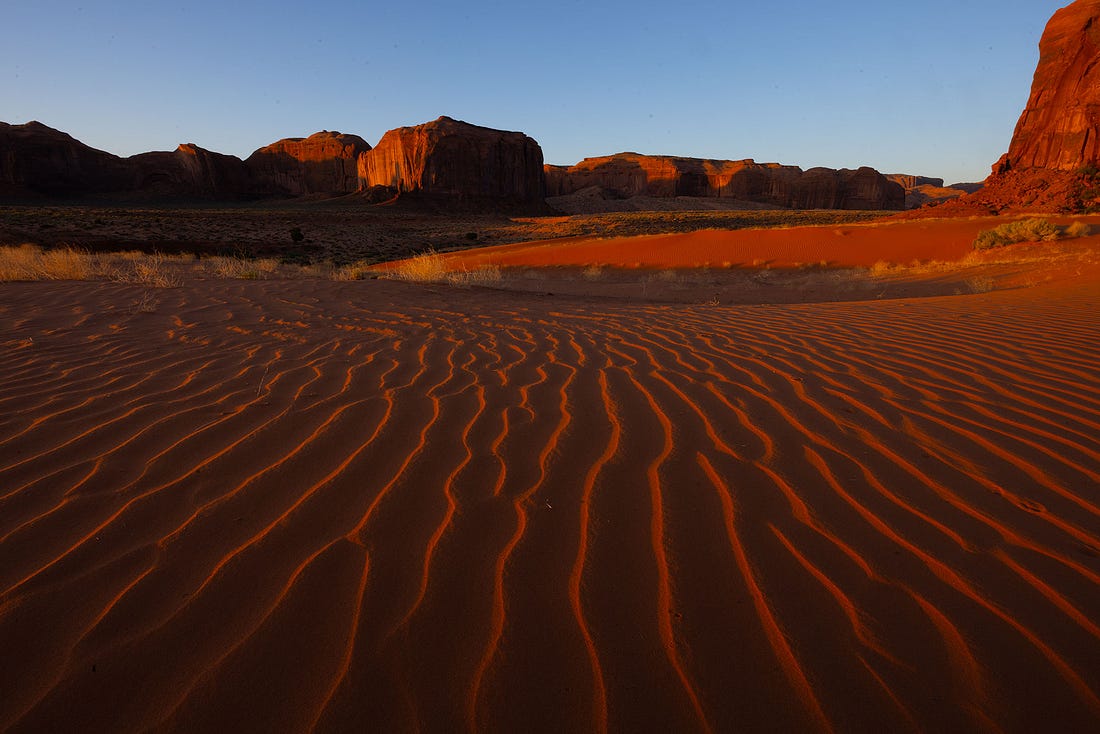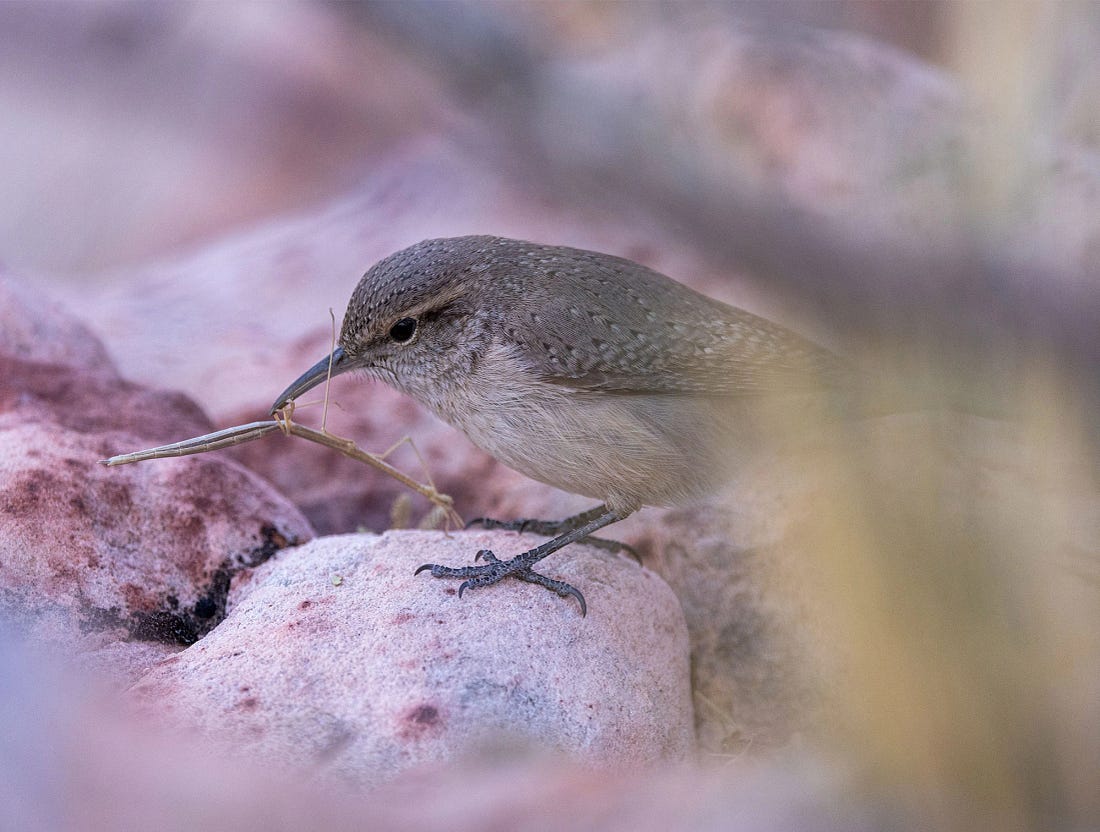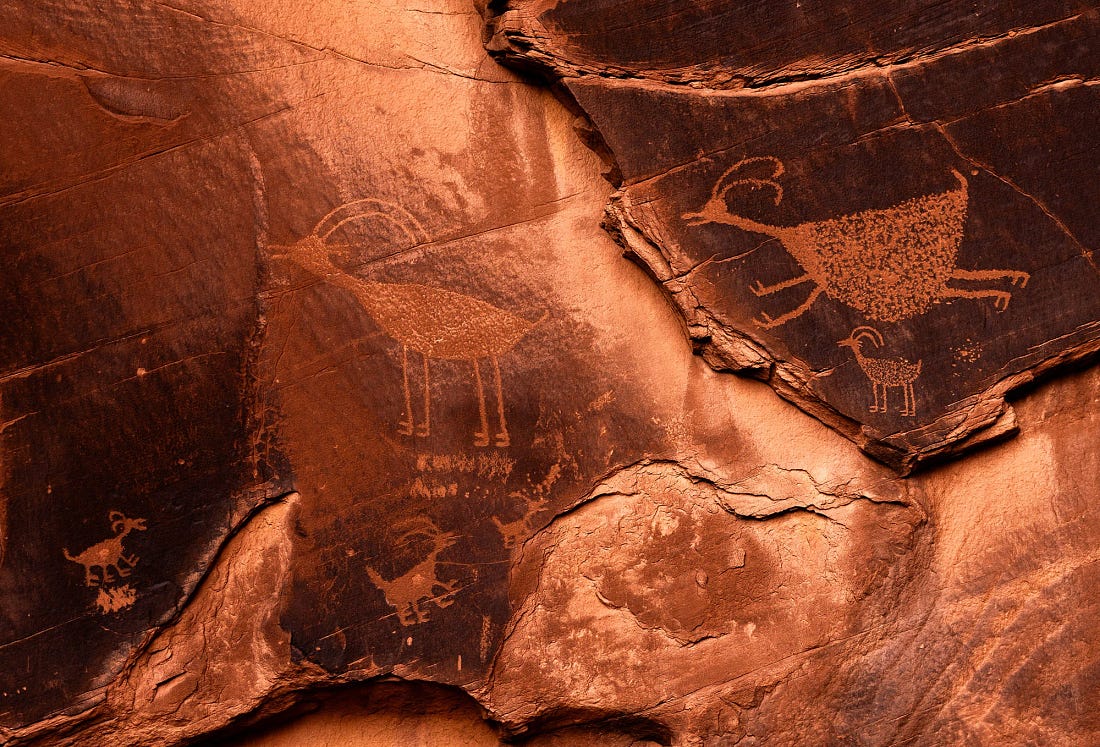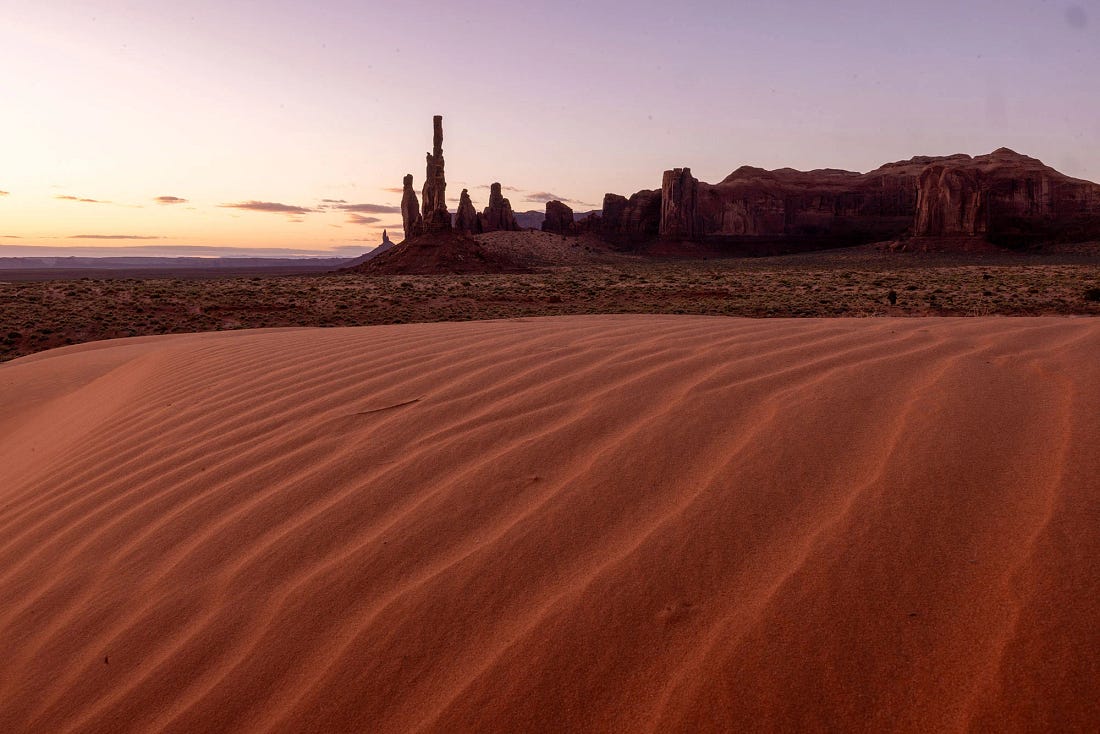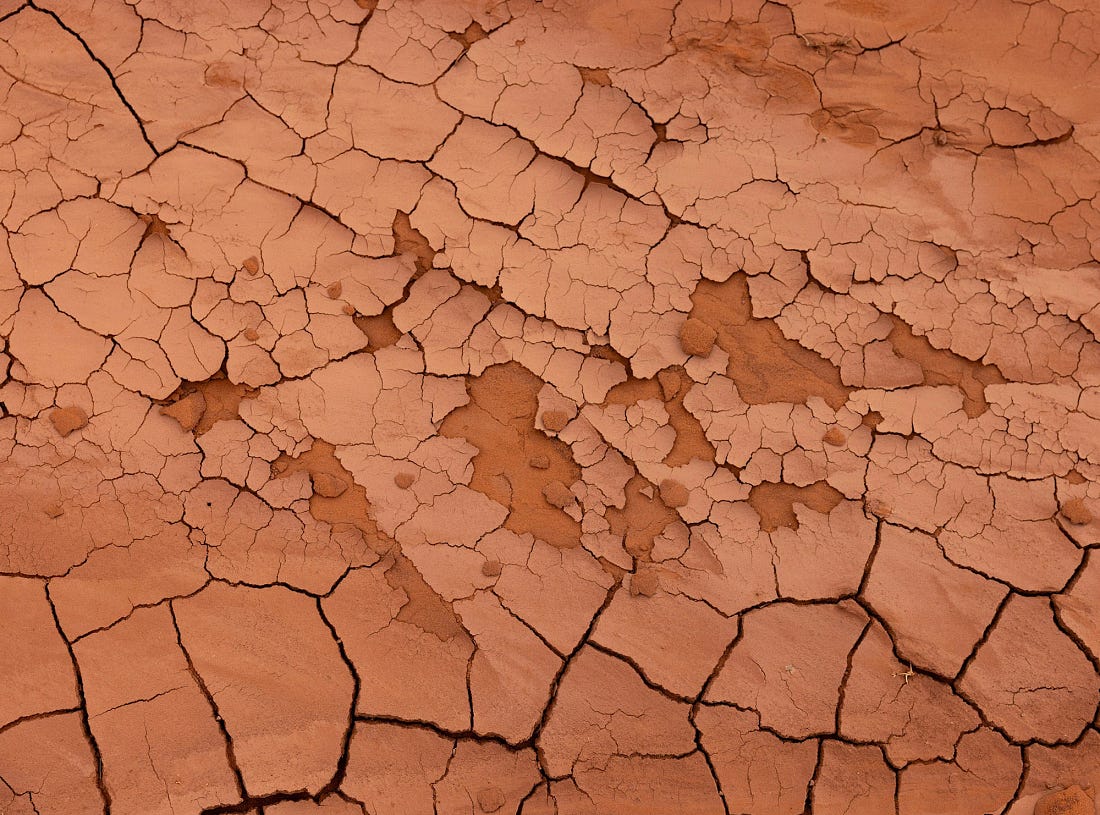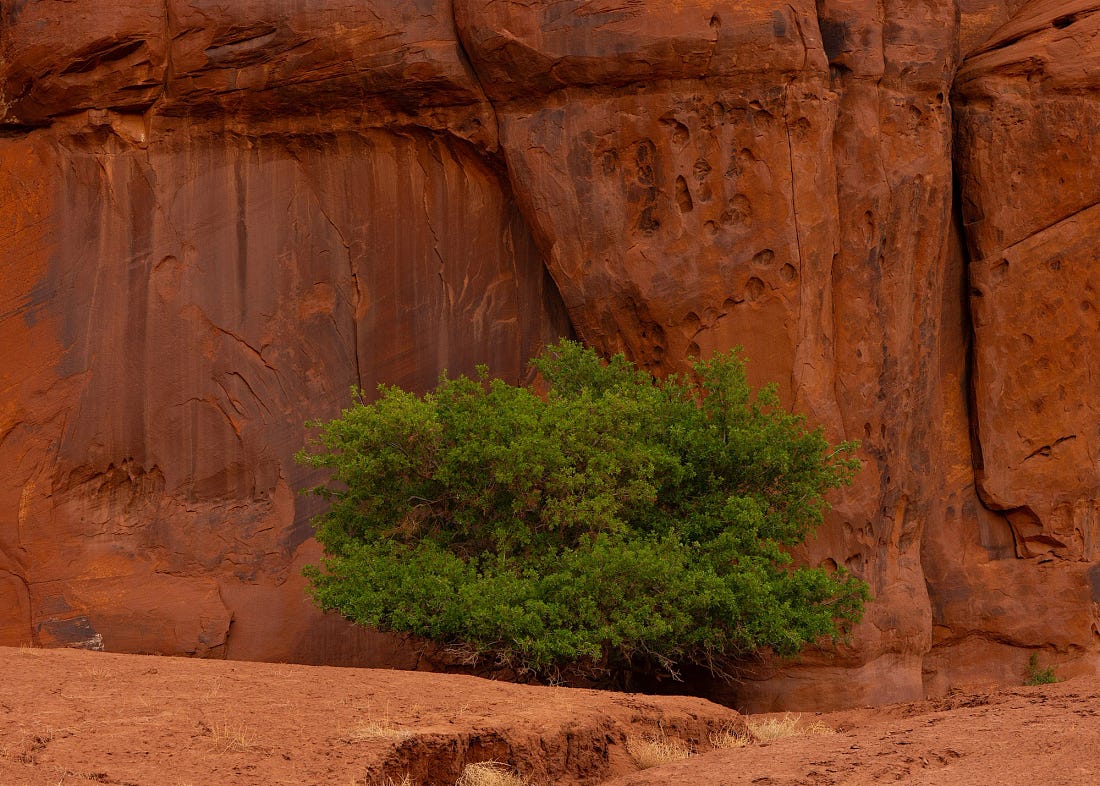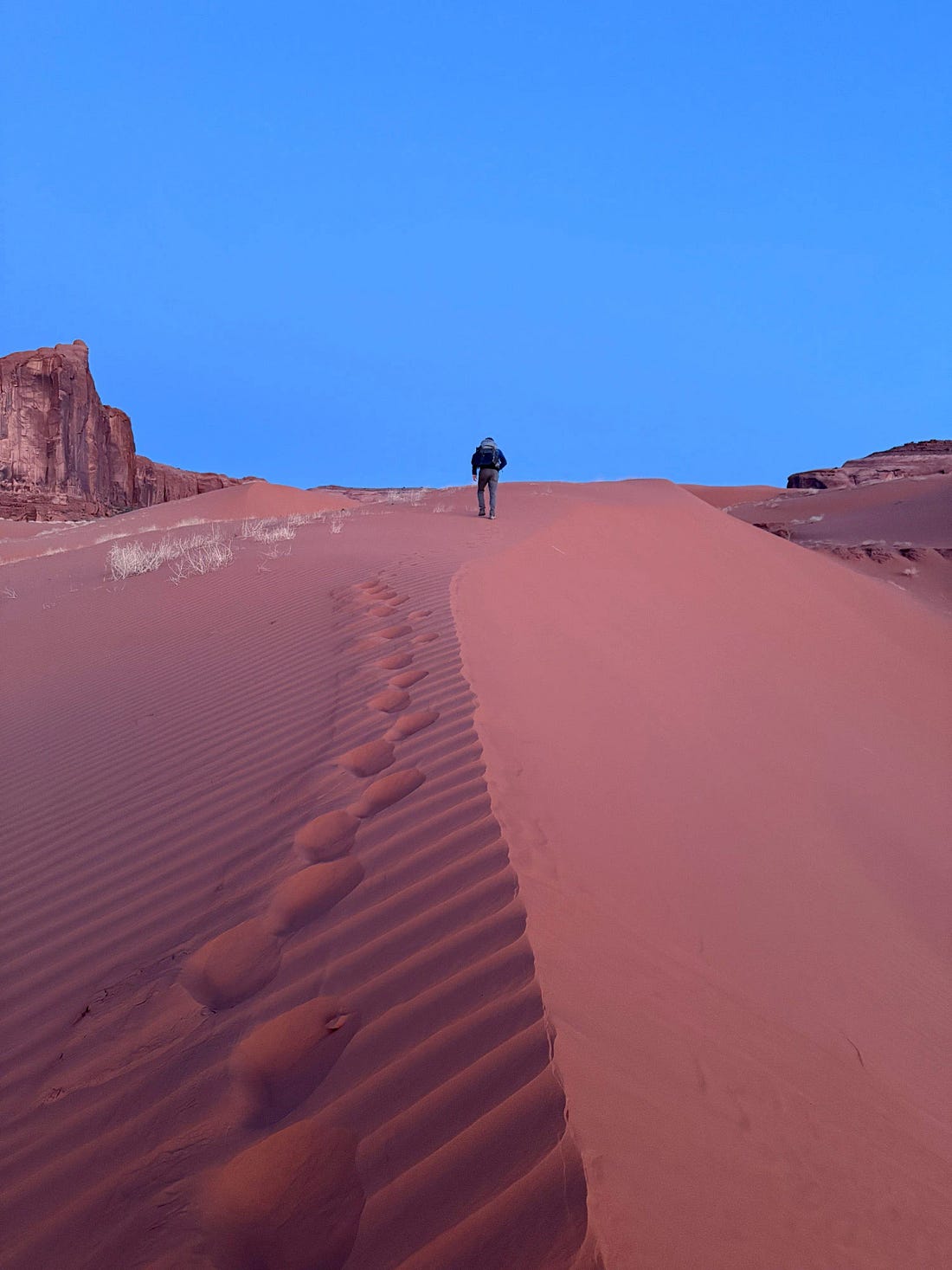Breakfast in Monument Valley, Clues in the CliffsBetween petroglyphs and pancakes, error itself becomes our method for glimpsing the vanished Pueblo world.Notes from the Road is always best read on site with high-resolution images on a desktop, laptop or tablet. Read on-site. It is breakfast time in Oljato, the small Navajo settlement inside Monument Valley, and there is only one place for eggs and coffee. My friend Brian and I sit in a booth at the Stagecoach Dining Room at Goulding’s Lodge, its big windows looking out toward the mesas. Yesterday, with Stanley, a Navajo guide, we spent our second morning in the restricted backcountry region of Monument Valley near the remote Sand Springs area, off-limits without a Navajo guide. Sand Springs itself is a small seep of water, so unusual in this region, and it feeds a line of bright green trees along its track. Above the spring itself is one of the Desert Southwest’s most gorgeous zones: miles of reddish-orange sand dunes, the soft leftovers of eroded sandstone monoliths. Yesterday, leaving the restricted area, our guide Stanley drove us to the base of a large sandstone butte and showed us a panel of Flying Sheep petroglyphs, likely depictions of Desert Bighorn Sheep etched in motion, their bodies half-leaping, or maybe even in a trance-like flight. But I was confused by the fact that these petroglyphs stood at ground level at the base of a ledged cliff that had been an Ancestral Puebloan cliff dwelling. The idea that people chose to live up there, in the cracks of this rounded monolith, stunned me. Stanley pointed out the faint outlines of masonry high in the cliffs, and the remains of a granary where corn was once stored. I asked Stanley how people reached these heights. He told me: “You know, they were very small people, but they were agile and strong. Maybe they had log ladders. But they probably could have climbed rock that we cannot imagine now.” Now, over pancakes, I tell Brian that I had always assumed the Ancestral Puebloans simply lived in the cliffs, as if that was the way they had been living for hundreds of years. But now I know that was not the case at all. In fact, the Ancestral Puebloans rushed into the cliffs out of urgency, retreat, and defense. But what happened to them? Why did they retreat into the heights and why did they suddenly vanish from Monument Valley and the Four Corners region altogether? As we volley back and forth, I begin to suspect that our misreadings and false starts might actually be the best way to approach this history. To learn the Ancestral Pueblo mystery, perhaps we can accept that each scenario is partly right, partly wrong, and that the cliff dwellers themselves will likely hover, like those flying sheep, somewhere between history and myth. As we both gravitate towards more current assessments of what happened in the Four Corners region, we let our half-baked theories run wild. Did Beasts from the South Drive the Puebloans into the Cliffs?The American Southwest was once home to the Shasta Ground Sloth, Nothrotheriops shastensis, a herbivore about the size of a black bear that fed on desert plants like agave, mesquite, and beavertail cactus pads. Rock art panels in Utah and elsewhere depict animals with long claws and hunched backs, images that many researchers identify as larger sloths. These petroglyphs, alongside depictions of mammoths, suggest that early peoples not only saw this other creature, but carved their likeness into stone. You can read into this evidence and deduce that conditions farther south in Central or South America created an upheaval in sloth populations. Giant Ground Sloths, far larger than the Shasta, may have urgently migrated northward under the same pressures that drove mammoths and other megafauna across continents. Suddenly, thousands of these giants would have flooded into Monument Valley and elsewhere in the Four Corners region. With bodies weighing several tons and claws over a foot long, these animals represented an immediate danger to any humans living in open villages. Their diet may have been plants, but their sheer size and defensive aggression made encounters deadly. (Petroglyph of Giant Sloth and Humans) A sloth could disembowel a human in an instant; those who were not torn down were forced to flee. But where? Faced with a predator they could not hunt or withstand and certainly couldn’t comprehend, the Ancestral Puebloans had only one place to go. They abandoned their ground-level dwellings and moved into alcoves high on cliff faces. The problem with this theory is that it has no basis in reality. We made it up after I had my third cup of coffee. The Shasta Ground Sloth went extinct about 11,000 years ago, at the end of the last Ice Age. Humans lived alongside them, hunted them, and left their bones marked with cuts, but this was long before the Ancestral Puebloan cliff dwellings of the 1200s and 1300s. Similarly, evidence of humans butchering Giant Ground Sloths is found often. Pictographs portray the species in places like Argentina and Uruguay. By the time places like Mesa Verde and Betatakin, now part of Navajo National Monument, rose into the alcoves, the sloths, both Shasta and giant, had been gone for ten thousand years. The rock art may capture ancient encounters, but it cannot explain the cliff dwellings. The scenario collapses under its own timeline.
Did Volcanoes Force Them Higher?Animals did not bring the Ancestral Puebloans into the cliffs, but if not animals, what about the Earth itself? A series of violent eruptions, each one hurling ash into the air and burying the valleys in gray dust, forced the Ancestral Puebloans into the cliffs. The lowlands became unlivable, cornfields were smothered under layers of ash, and the air was thick with sulfur and soot. Wild game like Desert Bighorn Sheep and Pronghorns disappeared. Families that didn’t suffocate carried what they could and climbed into high alcoves where the air was cleaner and the soil less poisoned. Cliff dwellings were the only safe ground above a poisoned Earth. The reality is that volcanic eruptions did shape the history of the Southwest, just not here, not then. But no eruptions touched the Four Corners in the 1200s. The cliff dwellings rose centuries after Sunset Crater to the south, which displaced other Ancestral Puebloan people. Was Cliff Living a Religious Devotion?But maybe it was something else altogether? What if the Puebloans saw the cliffs not as defenses but as devotion. Imagine a sect we might call the Stoneseers, a religious order convinced that true communion with the spirits required living in the very bones of the earth. To carve homes into cliffs was to carve a path toward the sacred, alcoves and smoke-blackened chambers serving as sanctuaries of worship. The climb itself became ritual, each ascent bringing them closer to the spirits of rain and corn. Their doctrine spread from village to village. Children learned to chant as they climbed, reciting prayers that bound their body to the holy rock. The great alcoves were temples filled with families who believed they had brought the world of the gods into their daily lives. The problem is the evidence. Religion was central to Ancestral Puebloan life, but there is no trace of a cult like the Stoneseers. Kivas carved into rock, often aligned to the night sky, confirm how ritual shaped where communities built. Petroglyphs and other rock art murals suggest a sophisticated cosmology that linked earth, sky, and ancestors. But no archaeologist has found proof that cliff living itself was devotional. What we do know is that spiritual belief helped dictate where communities were built. Many cliff dwellings incorporate these kivas directly into their heights. They were cut into bedrock and designed to align with night sky events. Some alcoves appear chosen for acoustics, where chants and drums might carry through the canyon. Did the Great Drought Collapse Their World?When Jared Diamond’s Collapse: How Societies Choose to Fail or Succeed came out, I bought the hard cover the day it hit the shelves. This was the answer to the mystery of the cliff dwellers. Drought struck, the crops failed, and the people of the Four Corners collapsed. Diamond, himself an evolutionary biologist, was synthesizing the new archaeological consensus, and finally offering a plausible answer to the mystery of the cliff dwellers in a popular work of nonfiction. The case began in the wood. The beams of cliff dwellings preserved the rings of trees from that era, a definitive tell of what was happening in the Southwest precisely when the Ancestral Puebloans climbed into the sandstone. When dendrochronologists lined those rings up against modern records, the signal leapt out. Beginning in 1276, the region entered the Great Drought, twenty-three years with little to no rain. Narrow tree rings showed the same pattern across hundreds of sites in the Four Corners region. The Great Drought meant famine. Diamond put it bluntly. “The drought beginning in A.D. 1276, lasting for 23 years, was the final straw,” he wrote. “Harvests failed repeatedly, and people starved or moved away” (*Collapse*, p. 146). Other evidence locked into place. Packrat middens, the fossilized trash heaps of desert rodents, preserved more clues. The middens showed that piñon and juniper, which had been essential for food and fuel, were missing from the hillsides by the late 1200s. Pollen records also matched the evidence for this ecological unravelling. In the middens, the story was clear. Soils had become exhausted by centuries of corn cultivation. Ancestral Puebloans stripped their forests clear for beams and firewood. Alongside all of this, biodiversity and game-meat sources were collapsing. Archaeologists mapped abandoned farm terraces and water-controlling check dams where floods cut through once-fertile fields. By the Great Drought, erosion scarred the valleys and the land was dead to agriculture. The cliff dwellings were not religious shrines, but rather the last stop in a downward spiral. Families perched in alcoves above fields they could no longer farm, buying themselves another season, maybe two, in the shadow of stone. The villages in the sky were the final escape of a desperate people, unable to survive off the land that had sustained them for millennia. For archaeologists in the early 2000s, the evidence that the Ancestral Puebloan society collapsed because the land gave out was crystal clear. But it turns out that this storyline, even with its massive and commanding archaeological evidence, was incomplete. There was new evidence: burned rooms, defensive towers, bones scratched with human violence. The drought was real; the story, it turned out, was not that simple. As new excavations, dating techniques, and regional surveys accumulated, archaeologists began to notice patterns that climate alone could not explain. Entire villages did not just wither away from hunger; they were burned to the ground. Defensive walls and towers, once considered minor features of these societies, were recognized as defensive fortifications. Human remains showed signs of trauma. Violence, whether in the form of raids or civil conflict, had played a role in the story. Were They Driven Up by Invaders?So, is this what really happened? The aggressors came from the north. Athabaskan people, the ancestors of the Navajo and Apache, moved down from the plains into the Four Corners. They were lean, mobile hunters, their hair bound back with leather thongs, their clothing was made of hides and woven yucca cord. Unlike the stone-built pueblos, their world was designed for continuous movement. They lived in skin lodges and brush shelters that could be taken down in an afternoon. They lived in motion on trails that stretched from the high plains to the desert basins. They carried atlatls with long, fletched darts, war clubs of polished stone, and shields of thick buffalo hide painted with protective symbols. From the villages of the Four Corners region, you can imagine their arrival of doom. Narrow columns of men advancing through piñon and sage, moving quickly, leaving little trace. They would have struck Monument Valley at dawn, slipping into villages where corn lay stored in bins and turkeys roosted in pens. The Puebloan world was a villager world, a world of fields and irrigation channels. The Athabaskans could vanish into the canyons as quickly as they had appeared, making off with captives, stealing food, setting roofs ablaze. The Four Corners, with its hundreds of connected societies, was easy pickings. The archaeological record seems to support this scenario. At Castle Rock Pueblo in Colorado, archaeologists uncovered evidence of a massacre in the late 1200s: at least forty men, women, and children killed, their bones scattered among burned architecture. As journalist David Roberts wrote in Smithsonian Magazine (July 2003), “In one room, archaeologists found a pile of disarticulated human bones, more than 40 individuals in all. Cut marks on the bones, cracked skulls, and ash mixed with the remains told of a massacre, not a peaceful abandonment”. At Mesa Verde, towers once thought to be religious-based are now widely believed to have been defensive, their sightlines were designed to monitor approaches to the alcoves. Roberts described one ruin “halfway up a sheer cliff face” that could only be reached by crawling along a ledge “scarcely wider than your body,” its walls “riddled with loopholes, narrow openings that allowed the defenders to shoot out while remaining protected within” (Smithsonian Magazine, July 2003). At Sacred Ridge, south of Durango, Colorado, the remains of more than thirty people showed extreme trauma, smashed skulls and dismembered bones, a scale of violence that shocked even seasoned researchers. Burn layers, collapsed walls, and arrow points embedded in bone all suggested open conflict, not simple environmental abandonment. Now we see that the cliff dwellings were fortresses. Masonry walls closed off alcoves, ladders were pulled up behind defenders, and granaries were hidden in crevices that were invisible to outsiders. Families could scan the desert valleys high on the rock, looking out for the next raid to break against stone walls. The Four Corners was a borderland. The villages of farmers were the last strongholds against the weight of a new outside force. The problem here is not the violence, but the outsiders. The Athabaskans did come south, but most linguistic, archaeological, and genetic evidence places their migration centuries later, between the 1400s and 1500s, long after the cliff dwellings had already been abandoned. By the time Navajo and Apache groups were establishing themselves in the Southwest, the great alcove civilizations were long empty. As archaeologist William Lipe told Roberts, “There’s simply no evidence of nomadic tribes in this area in the 13th century. If there were enough nomads to drive out tens of thousands of people, surely the invaders would have left plenty of archaeological evidence” (Smithsonian Magazine, July 2003). The burned pueblos, the fractured skulls, the defensive towers, all are real, but they likely tell of conflict between Puebloan groups themselves, neighbors turned rivals in a time of scarcity. The cliff dwellings were defensive, but the enemies were close by. Did an Authoritarian Ruler Divide Them?By the late 1200s, drought had hollowed Puebloan life; the land could no longer support the great houses. Out of this vacuum of scarcity emerged a leader who promised certainty amid ruin. We don’t know his name; we’ll call him White Shell Ruler. Imagine petroglyphs depicting a figure wearing necklaces of carved shell and turquoise, his hair bound back with yucca cord. One carving shows him apparently speaking to a group of followers. He is believed to have claimed that the drought was no accident but divine punishment for those who doubted him. He rewarded loyalists with food, cast out dissenters, and turned his troops against rival great houses. As starvation among the outcast created desperation and insurgency, he directed his troops to the Great Houses that refused his reign, to have them slaughtered. The drought had hollowed the land, but it hadn’t hollowed skulls. White Shell Ruler set villages aflame while erecting walls and defensive towers around his loyalists. Yes, the Pueblo world fell apart because of environmental scarcity, but it was people…neighbors, rivals, factions…who turned the valleys into battlegrounds. This era of authoritarianism and state-inspired violence led to only one possibility. If you were not a White Shell Ruler loyalist, you had to escape. This is how the Puebloan people ran up into the cliffs. Hiding inside the alcoves, survival was brutal but possible. Granaries were tucked into crevices where food could be hidden from raiders. Ladders could be pulled up, cutting off pursuit. Children learned to climb rock faces as easily as they once ran across their flat village fields. Fires burned in smoke-blackened rooms deep in the stone, their ventilation carefully controlled. Springs dripped from canyon walls, and small gardens were tended on mesa tops. Life became about endurance and survival, but it was a life with working defenses against the strongmen below. Like modern authoritarians, White Shell Ruler mocked his rivals and turned hunger into a weapon, distributing corn based on allegiance. He claimed the mantle of tradition while breaking with it, replacing shared leadership with singular power. His rhetoric was blunt: the drought was not a failure of rain, but a failure of faith, of faith in him. His enemies were not across the desert, but among his own people. Under his rule, violence was not random but sanctioned, a spectacle to frighten dissenters into obedience. We can imagine this scenario because we have seen it in our very recent history. As drought and deforestation once unmade the Four Corners, today’s warming planet has elevated leaders who thrive on division. Scarcity of water and food, rising seas, and burned forests have become stages on which strongmen rise, denying science, scapegoating the vulnerable, and offering false certainties. In Syria, a historic drought from 2006 to 2010 emptied farmland and drove millions into the cities. Bashar al-Assad’s regime didn’t look to help his people with relief, but used it as an opportunity to inflame grievances that helped ignite a civil war. In Sudan’s Darfur, desertification was twisted by Omar al-Bashir into an ethnic war, with entire communities cast as enemies in a fight over vanishing land. And in the Mediterranean world, as I wrote about in my Malta notes, leaders have used the language of scarcity and migration to rally followers, turning climate stress into nationalism and fear. Then as now, environmental collapse fractured communities, and those fractures were widened by men who promised safety to the loyal while branding the rest as enemies. The problem is the man himself. Archaeologists have found no trace of a White Shell Ruler figure. Yet imagining him helps explain the evidence, and the story of the White Shell Ruler, although made up at breakfast at the Stagecoach Dining Room, mirrors the most current evidence. Environmental collapse created scarcity, scarcity fueled fear, and fear opened the door to authoritarian dynamics. There may have been no White Shell Ruler of the thirteenth century, but the pattern of drought, fear, and division leading to authoritarianism remains the most plausible way to understand why the Ancestral Puebloan people climbed into the cliffs and built stone villages in the sky. Or Does the Mystery Endure?But the Ancestral Puebloan mystery doesn’t end there. After the Four Corners emptied, survivors moved south and east into the Rio Grande valleys, the Zuni pueblos, and the Hopi mesas. There, the Kachina cult emerged, offering peace and balance where the old order had fractured. If so, the cliff dwellings were both an end and a passage: the last stand of a broken world, and the threshold of another. Brian and I hold our patchwork of truths and inventions, knowing that dismissed theories often return in new light. Some mysteries are best learned this way — half-wrong, half-right, always shifting. Treating knowledge as provisional isn’t uncertainty at all — it’s the most durable kind of certainty we get. Outside the diner window, it’s a bright sunny day. The dust storms from earlier in the week are gone. Soon we will be back in the car, heading toward New Mexico. If the Ancestral Puebloans migrated to the Rio Grande in search of renewal, then may we too cross these desert roads toward a land of new beginnings. Notes from the Road is free today. But if you enjoyed this post, you can tell Notes from the Road that their writing is valuable by pledging a future subscription. You won't be charged unless they enable payments. |

